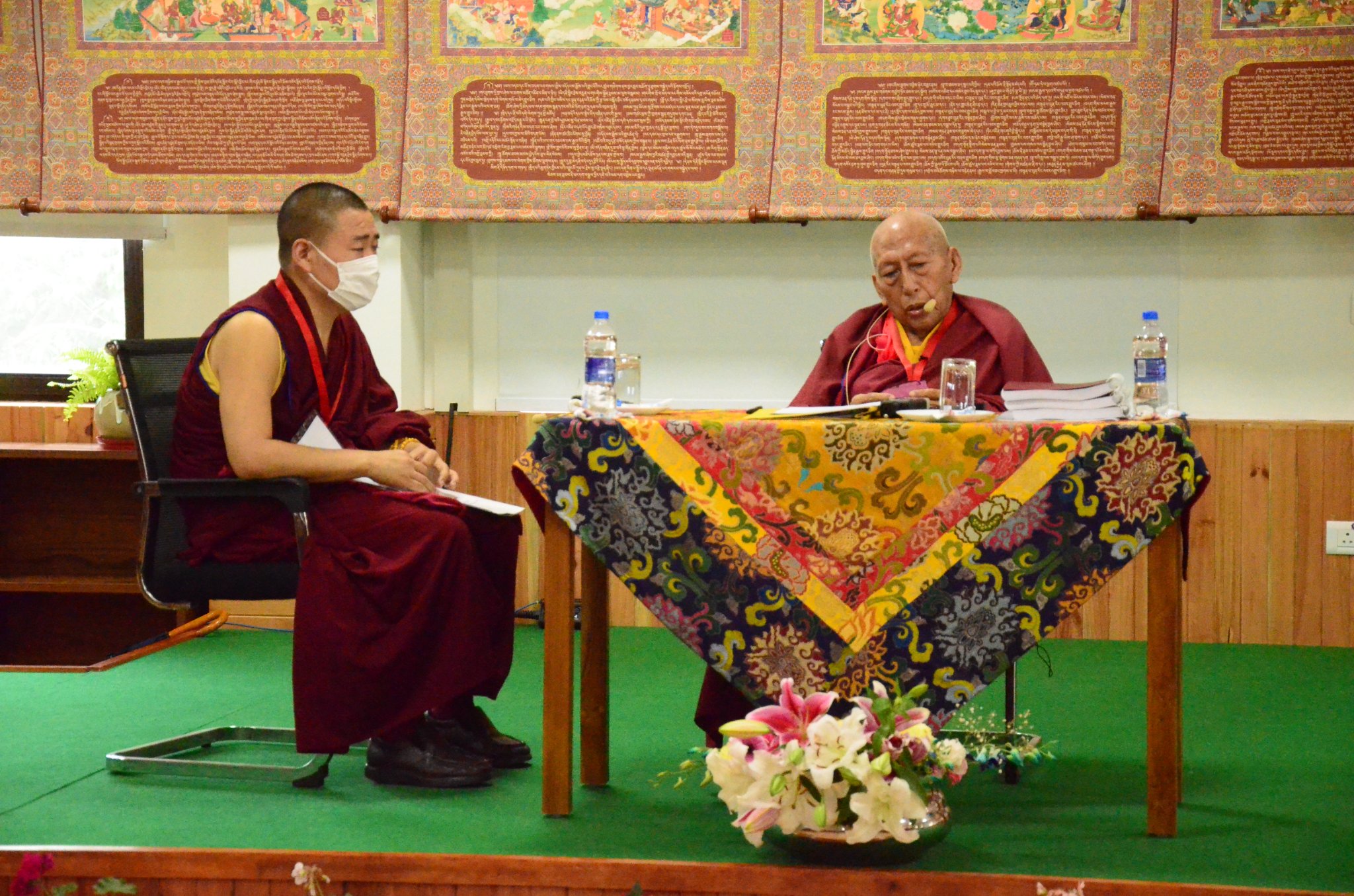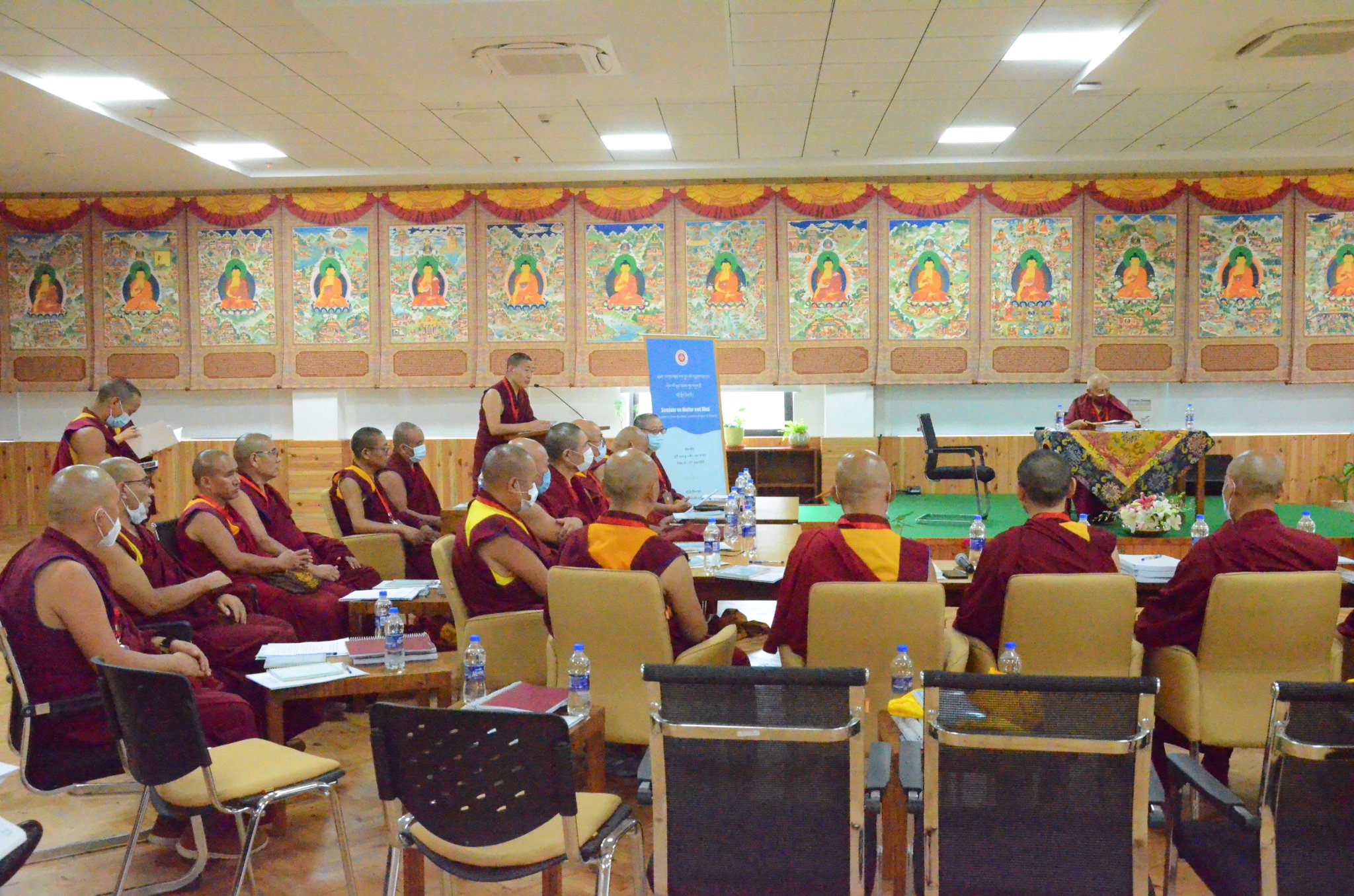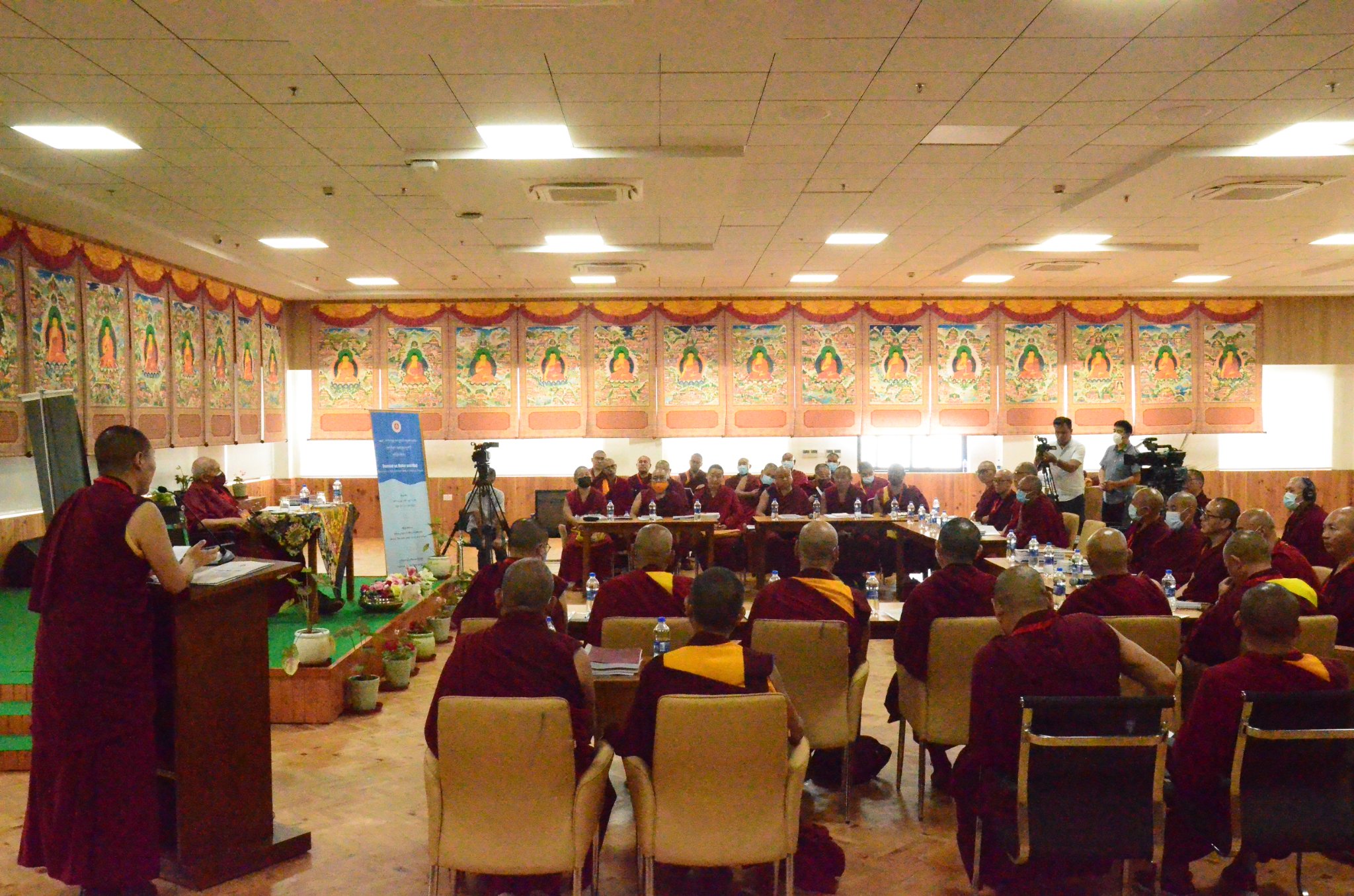His Eminence Prof. Samdhong Rinpoche gave a talk at the seminar on “Explanation from Buddha’s Teachings and Commentarial Texts on Matter and Mind”
In the evening of 8 July 2022, His Eminence Prof. Samdhong Rinpoche gave a talk at the seminar on “Explanation from Buddha’s Teachings and Commentarial Texts on Matter and Mind”, organised by The Dalai Lama Trust, and convened in the hall of Dalai Lama Library and Archives, Dharamshala. The seminar was in relation to the three-volume compilation of citations from Buddha’s Words and commentarial texts, on the mind, to be the reference basis for others studying Buddhist science of the mind.
His Eminence Rinpoche was among those who first mentioned to His Holiness the Dalai Lama the need for a compilation of citations on the mind, from Buddhist teachings, His Eminence said. That His Holiness the Dalai Lama has remarked that the modern science’s and Western understanding of the mind is at the level of kindergarten, is not a poetic fabrication, rather it is factual, and His Eminence has come across some Western experts who are of the view that the remark puts the comparison at slightly too high a level. As such, His Eminence felt it is important that it be made very clear before the world at large how profound and vast it is the knowledge-heritage of Buddhist explanation concerning the mind.
His Eminence Rinpoche gave the example of Gandhi pointing out the excellence of the traditional education system of India prior to the colonial system enforced by Macaulay, and narrated how the scholar the late Dharmpal, a friend of His Eminence’s, specifically went to London and spent five years researching the archives at the India Library, while working as a postal delivery man, and revealed the greatness of the traditional Indian education system as recorded in their own records of the British. Borrowing Gandhi’s analogy of the excellent traditional Indian education system as “the beautiful tree”, a wish-fulfilling tree, Dharmpal gave it as the title of the book of his findings.
During the period of some eight-nine thousand years of recorded history of the world, and those preceding them, known as “[the narratives of] the past events”, there have been numerous spiritual faiths and philosophical tenets, and of them, those asserting a presentation of the mundane and the beyond fundamentally comes down to the variation in explaining the inanimate and the mind. And of all the diverse spiritual systems and philosophies, there is not any other that has such a vast corpus of founding teacher’s spoken teachings put into writing as that of Buddhism. Even if all the teachings of the classical ‘five’ or ‘six’ groups of the philosophical schools tarkika-s’ put together would hardly compare to just one pitaka of the Tripitaka of the Buddhists. Sometimes, in jest I say to my non-Buddhist friends, ‘If you study the one book that’s your teachings, you could consider to have studied all of your teachings. It’s very convenient. It would take several lifetimes to study all of the Buddhist teachings; it would be difficult to just complete reading once the Kagyur and Tangyur in one lifetime.’
Not only our teachings are so vast, the presentation of the mind in Buddhism is very extensive as well. In the West, if we look at last some four-five hundred years, there were the two philosophical views, of Idealism and Materialism. The proponents of the former were Hegel and others, and as for the latter, Marx and others propounded a “Dialectical Materialism”. Both sides were discussing about the mind and material things, yet it would be difficult to be explaining about the mind.
Among the classical non-Buddhist tenets, there were some that attempted to elaborate on the mind, by labelling a dominant mind as “the awareness” or “the great”. Of those believing in a Creator, there were many that explained the mind as of two parts: the Creator’s, that is “the great mind”, and the individual mind of a person; and when a person’s mind strays from the great mind it is the wandering in samsara, and when it absorbs into the great mind, that was explained to be the attaining of liberation.
Everyone thus presented the mind in a convenient way—none of them saw the mind in its depth and details as was explained in the Buddhist texts. They did not see, nor explained, nor wrote about the mind. It is clear that there is not any other system that has such an extensive explanation of the mind as of the Buddhists’. In the Western course of education at present the study of the mind is set apart as “Psychology”, a major subject. When compared with Buddhist presentation of the mind and the secondary minds, it is very brief and convenient. The mind is looked at by looking at the workings of brain, and the two are viewed as if the same. They are not able to differentiate between the matter (a thing with form) and the mind, the consciousness. Psychology mainly constitutes of the clinical aspect, of examining those that are mentally unwell and ways of curing them, there is not much explained as regards the mind.
And thus when His Holiness the Dalai Lama regularly speaks of the Buddhist presentation of the mind, His Holiness is not referring just to the English term “psychology”; His Holiness uses, in English, a new terminology, “science of the mind”. It is more comprehensive, covering psychology and the entire ways of viewing the mind by scientists.
In recent times, there have been quite a number of philosophers who explained about the mind. My late friend Jiddu Krishnamurti, for instance—his entire philosophy was around the mind. Through his experience he saw that there would have to be two kinds of consciousnesses: sensory consciousness and the mental consciousness, which in our Buddhist terminology would be more conveniently described as “conceptual consciousness” and “non-conceptual consciousness”, a consciousness that directly perceives a thing, and a consciousness that retains a blend of label and thing. When it is seen, through experience, that there are two kinds of consciousnesses they give a new terminology: “the perceiving mind” and “the conceiving mind”.
That a conceptual thought is defined as “an awareness which retains a blend of label and thing” is perhaps a unique Tibetan expression, although this is not to say such was not in the Sanskrit. The Hindi word for a conceptual thought is a convenient one: “vikalp”, which literally translates as option, with the meaning that it is not a singular, rather a situation of two—the label and the thing—coming blended. And it is seen that the conceptual thought is a primary cause for getting bound to the mundane existence.
In such a circuitous route, the present-day physicists, and more so the quantum physicists are taking interest in the mind. And this interest came about in relation to Western Idealism of Hegel and others. Among the first of the physicists who saw the vastness of the presentation of the mind from Buddhist teachings and that it would be worth taking interest in was Fritjof Capra, the author of The Tao of Physics. At the time we met he was writing the next book The Turning Point. In that first book, he had written about Buddhist understanding of the mind and reality. Thereafter, it was the physicist David Bohm, who met His Holiness the Dalai Lama many times, and also had dialectical discussions with Jiddu Krishnamurti. But when they spoke of their interest in the Buddhist science of the mind they experienced risks of becoming excluded among the ranks of scientists. Now, at present, due to the enlightened initiatives of His Holiness the Dalai Lama, around the world there is an interest being shown by many scientists in Buddhist science in general, and more so in Buddhist science of the mind. They are at the stage of struggle, not yet able to make it clear to the scientific community that their interest is genuine. Many of their scientific colleagues see them as incomplete in their thinking, and going under the influence of another culture, and they stay risking of becoming excluded from the mainstream scientists. Within the next hundred years if there forms a good relation between modern science and Buddhist science—particularly, the Buddhist science of the mind—there will be the influence of lovingkindness and compassion with science and technology throughout the world; at present, the situation is where science and technology follow the influence of violence and competition.
His Eminence Rinpoche further talked in considerable details about the need to understand the mind and its many aspects, in experiential realisations, not merely to be able to verbally parrot things at a dialectical debate. For instance, the purport of the lines from the teachings, “the nature of the mind is clear-light, the stains are adventitious”—it seems this is not quite easy to explain, to be understood. That the mental stains are adventitious, that they are not within the nature of the mind, may not be that easy to be understood, for the stains are mind, and when they cease or when they are eschewed, does a “clear and knowing” part continues to flow, or would that “clear and knowing” part cease together with a stain? There are many things of such kind that do not come in our regular dialectical debates. Let’s say, the assertion that “a mind {knower} would have a mind preceding it, because it is a mind”—if we are not able to know well the conventional state of the mind in its arising-abiding-and-ceasing, it would be difficult to establish that entailment. It may be easy to verbally say that logical entailment, but it might be difficult to have the understanding in the mind what that means. When we regularly do our studies it would be important to do so with the three inseparably: learning, reflection and meditative familiarisation. What we learn, we reflect on them and verify through reflection, and thereafter apply to our mental continuum through meditative familiarisation. This applies the same to the instructions on “the ways of introducing the mind” presented in Gedhen Great Seal, the Great Completion, the Great Seal, the Middle View, which ultimately arrive to the same realisation, as Panchen Losang Choegyan said, “When examined by an experienced practitioner| Adept at [Buddha’s] Words and reasoning on the definitive meaning,| [They all] arrive at the same purport.||”
With appreciation to the learned team of scholars who have compiled the three-volume Anthology on the Mind, His Eminence Rinpoche advised that it is important to make the world at large know the vastness, detailed and profundity of Buddhist science of the mind, not for our fame, rather to benefit the modern scientists and academics and others, through them doing studies on Buddhist science of the mind; to awaken well the innate seeds of lovingkindness and compassion that are within their mental continuum. That is the intent of His Holiness the Dalai Lama. The other objective of this project should be for us Buddhists to be able to understand the teachings on the mind and the secondary minds, not just to be able to say by mouth, rather to understand in our mind, and then to look at how to stop the inappropriate wandering of the mind that gives rise to the mental defilements, and thus to suppress for the time being the manifest gross mental defilements. Then, gradually, to remove from our mind the ignorance, the beginning of the twelve dependent-links, the root of all mental stains. To not leave our studies at the level of the words in general, but to apply to one’s practice and be able to gain understanding in one’s mind. When one daily does the practices to improve one’s mind, and more so when practising the completion stages, how through having identified the mode of the existence of the bases, phenomena—not just through “mere visualisation and belief”—one goes about with pivoting upon the mind, not just on the body, channels and elements. I do think there are means to pivot on both the channels and winds.
At the conclusion, His Eminence Rinpoche expressed hopes and prayers for the three-day discussion to be meaningful.
The video-recording of the talk, in Tibetan, at this link:


